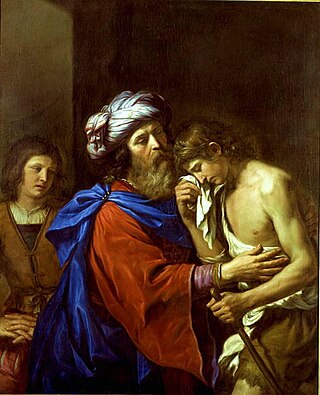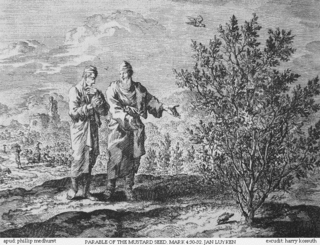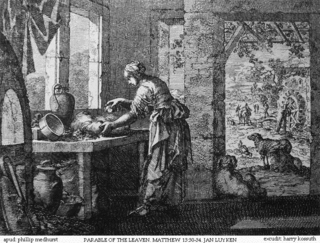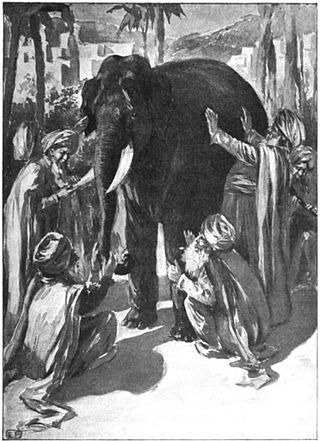
A metaphor is a figure of speech that, for rhetorical effect, directly refers to one thing by mentioning another. It may provide clarity or identify hidden similarities between two different ideas. Metaphors are usually meant to create a likeness or an analogy.

Metonymy is a figure of speech in which a concept is referred to by the name of something closely associated with that thing or concept.

A figure of speech or rhetorical figure is a word or phrase that intentionally deviates from ordinary language use to produce a rhetorical effect. Figures of speech are traditionally classified into schemes, which vary the ordinary sequence of words, and tropes, where words carry a meaning other than what they ordinarily signify.
The analogy of the Sun is found in the sixth book of The Republic (507b–509c), written by the Greek philosopher Plato as a dialogue between his brother Glaucon and Socrates, and narrated by the latter. Upon being urged by Glaucon to define goodness, a cautious Socrates professes himself incapable of doing so. Instead he draws an analogy and offers to talk about "the child of goodness". Socrates reveals this "child of goodness" to be the Sun, proposing that just as the Sun illuminates, bestowing the ability to see and be seen by the eye, with its light, so the idea of goodness illumines the intelligible with truth. While the analogy sets forth both epistemological and ontological theories, it is debated whether these are most authentic to the teaching of Socrates or its later interpretations by Plato.

A parable is a succinct, didactic story, in prose or verse, that illustrates one or more instructive lessons or principles. It differs from a fable in that fables employ animals, plants, inanimate objects, or forces of nature as characters, whereas parables have human characters. A parable is a type of metaphorical analogy.
In literature and writing, stylistically elements are the use of any of a variety of techniques to give an auxiliary meaning, ideas, or feeling to the literalism or written.

A Treatise of Human Nature: Being an Attempt to Introduce the Experimental Method of Reasoning into Moral Subjects (1739–40) is a book by Scottish philosopher David Hume, considered by many to be Hume's most important work and one of the most influential works in the history of philosophy. The Treatise is a classic statement of philosophical empiricism, scepticism, and naturalism. In the introduction Hume presents the idea of placing all science and philosophy on a novel foundation: namely, an empirical investigation into human nature. Impressed by Isaac Newton's achievements in the physical sciences, Hume sought to introduce the same experimental method of reasoning into the study of human psychology, with the aim of discovering the "extent and force of human understanding". Against the philosophical rationalists, Hume argues that the passions, rather than reason, cause human behaviour. He introduces the famous problem of induction, arguing that inductive reasoning and our beliefs regarding cause and effect cannot be justified by reason; instead, our faith in induction and causation is caused by mental habit and custom. Hume defends a sentimentalist account of morality, arguing that ethics is based on sentiment and the passions rather than reason, and famously declaring that "reason is, and ought only to be the slave to the passions". Hume also offers a sceptical theory of personal identity and a compatibilist account of free will.

The parables of Jesus are found in the Synoptic Gospels and some of the non-canonical gospels. They form approximately one third of his recorded teachings. Christians place great emphasis on these parables, which they generally regard as the words of Jesus.

The Parable of the Mustard Seed is one of the shorter parables of Jesus. It appears in Matthew (13:31–32), Mark (4:30–32), and Luke (13:18–19). In the Gospels of Matthew and Luke, it is immediately followed by the Parable of the Leaven, which shares this parable's theme of the Kingdom of Heaven growing from small beginnings. It also appears in the non-canonical Gospel of Thomas.

The Parable of the Leaven, also called the parable of the yeast, is one of the shortest parables of Jesus. It appears in Matthew 13:33 and Luke 13:20–21, as well as in the non-canonical Gospel of Thomas. In the canonical gospels it immediately follows the Parable of the Mustard Seed, which shares this parable's theme of the Kingdom of Heaven growing from small beginnings. In the Gospel of Thomas it starts a series of three, preceding the Parable of the empty jar and the Parable of the Strong Man.

The Parable of the Hidden Treasure is a well known parable of Jesus, which appears in Matthew 13:44, and illustrates the great value of the Kingdom of Heaven. It immediately precedes the parable of the Pearl, which has a similar theme. The parable has been depicted by artists such as Rembrandt.

The parable of the blind men and an elephant is a story of a group of blind men who have never come across an elephant before and who learn and imagine what the elephant is like by touching it. Each blind man feels a different part of the animal's body, but only one part, such as the side or the tusk. They then describe the animal based on their limited experience and their descriptions of the elephant are different from each other. In some versions, they come to suspect that the other person is dishonest and they come to blows. The moral of the parable is that humans have a tendency to claim absolute truth based on their limited, subjective experience as they ignore other people's limited, subjective experiences which may be equally true. The parable originated in the ancient Indian subcontinent, from where it has been widely diffused.
The problem of religious language considers whether it is possible to talk about God meaningfully if the traditional conceptions of God as being incorporeal, infinite, and timeless, are accepted. Because these traditional conceptions of God make it difficult to describe God, religious language has the potential to be meaningless. Theories of religious language either attempt to demonstrate that such language is meaningless, or attempt to show how religious language can still be meaningful.
Adolf Jülicher was a German scholar and biblical exegete. Specifically, he was the Professor of Church History and New Testament Exegesis, at the University of Marburg. He was born in Falkenberg near Berlin and died in Marburg.
Homeric simile, also called an epic simile, is a detailed comparison in the form of a simile that are many lines in length. The word "Homeric", is based on the Greek author, Homer, who composed the two famous Greek epics, the Iliad and the Odyssey. Many authors continue to use this type of simile in their writings although it is usually found in classics.

In Plato's The Republic, a noble lie is a myth or a lie knowingly propagated by an elite to maintain social harmony. Plato presented the noble lie in the fictional tale known as the myth or parable of the metals in Book III. In it, Socrates provides the origin of the three social classes who compose the republic proposed by Plato. Socrates speaks of a socially stratified society as a metaphor for the soul, wherein the populace are told "a sort of Phoenician tale":
...the earth, as being their mother, delivered them, and now, as if their land were their mother and their nurse, they ought to take thought for her and defend her against any attack and regard the other citizens as their brothers and children of the self-same earth...While all of you, in the city, are brothers, we will say in our tale, yet god, in fashioning those of you who are fitted to hold rule, mingled gold in their generation, for which reason they are the most precious—but in the helpers, silver, and iron and brass in the farmers and other craftsmen. And, as you are all akin, though, for the most part, you will breed after your kinds, it may sometimes happen that a golden father would beget a silver son, and that a golden offspring would come from a silver sire, and that the rest would, in like manner, be born of one another. So that the first and chief injunction that the god lays upon the rulers is that of nothing else are they to be such careful guardians, and so intently observant as of the intermixture of these metals in the souls of their offspring, and if sons are born to them with an infusion of brass or iron they shall by no means give way to pity in their treatment of them, but shall assign to each the status due to his nature and thrust them out among the artisans or the farmers. And again, if from these there is born a son with unexpected gold or silver in his composition they shall honor such and bid them go up higher, some to the office of guardian, some to the assistanceship, alleging that there is an oracle that the city shall then be overthrown when the man of iron or brass is its guardian.
Ullurai is a type of extended allusion or metaphor used in classical Tamil poetry.
"Necessity is the mother of invention" is a proverb. It states that the primary driving force for most new inventions is a need.

"The Parable of the Sunfish" is an anecdote with which Ezra Pound opens ABC of Reading, a 1934 work of literary criticism. Pound uses this anecdote to emphasize an empirical approach for learning about art, in contrast to relying on commentary rooted in abstraction. While the parable is based on students' recollections of Louis Agassiz's teaching style, Pound's retelling diverges from these sources in several respects. The parable has been used to illustrate the benefits of scientific thinking, but more recent literary criticism has split on whether the parable accurately reflects the scientific process and calls into question Pound's empirical approach to literature.











